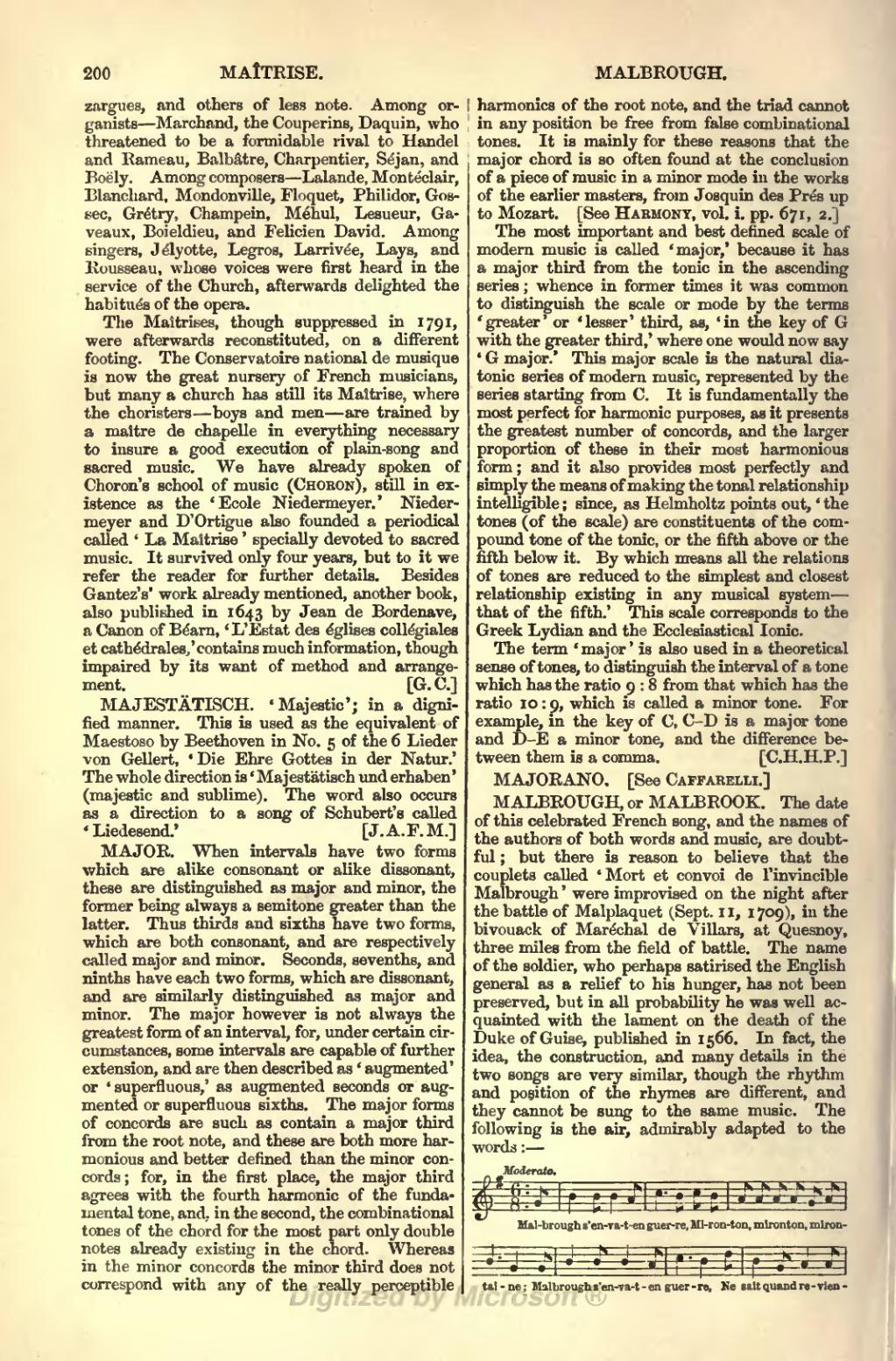zargues, and others of less note. Among organists—Marchand, the Couperins, Daquin, who threatened to be a formidable rival to Handel and Rameau, Balbâtre, Charpentier, Séjan, and Boëly. Among composers—Lalande, Montéclair, Blanchard, Mondonville, Floquet, Philidor, Gossec, Grétry, Champein, Méhul, Lesueur, Gaveaux, Boieldieu, and Felicien David. Among singers, Jélyotte, Legros, Larrivée, Lays, and Rousseau, whose voices were first heard in the service of the Church, afterwards delighted the habitués of the opera.
The Maîtrises, though suppressed in 1791, were afterwards reconstituted, on a different footing. The Conservatoire national de musique is now the great nursery of French musicians, but many a church has still its Maîtrise, where the choristers—boys and men—are trained by a maître de chapelle in everything necessary to insure a good execution of plain-song and sacred music. We have already spoken of Choron's school of music (Choron), still in existence as the 'Ecole Niedermeyer.' Niedermeyer and D'Ortigue also founded a periodical called 'La Maîtrise' specially devoted to sacred music. It survived only four years, but to it we refer the reader for further details. Besides Gantez's' work already mentioned, another book, also published in 1643 by Jean de Bordenave, a Canon of Béarn, 'L'Estat des églises collégiales et cathédrales,' contains much information, though impaired by its want of method and arrangement.
[ G. C. ]
MAJESTÄTISCH. 'Majestic'; in a dignified manner. This is used as the equivalent of Maestoso by Beethoven in No. 5 of the 6 Lieder von Gellert, 'Die Ehre Gottes in der Natur.' The whole direction is 'Majestätisch und erhaben' (majestic and sublime). The word also occurs as a direction to a song of Schubert's called 'Liedesend.'
[ J. A. F. M. ]
MAJOR. When intervals have two forms which are alike consonant or alike dissonant, these are distinguished as major and minor, the former being always a semitone greater than the latter. Thus thirds and sixths have two forms, which are both consonant, and are respectively called major and minor. Seconds, sevenths, and ninths have each two forms, which are dissonant, and are similarly distinguished as major and minor. The major however is not always the greatest form of an interval, for, under certain circumstances, some intervals are capable of further extension, and are then described as 'augmented' or 'superfluous,' as augmented seconds or augmented or superfluous sixths. The major forms of concords are such as contain a major third from the root note, and these are both more harmonious and better defined than the minor concords; for, in the first place, the major third agrees with the fourth harmonic of the fundamental tone, and, in the second, the combinational tones of the chord for the most part only double notes already existing in the chord. Whereas in the minor concords the minor third does not correspond with any of the really perceptible harmonics of the root note, and the triad cannot in any position be free from false combinational tones. It is mainly for these reasons that the major chord is so often found at the conclusion of a piece of music in a minor mode in the works of the earlier masters, from Josquin des Prés up to Mozart. [See Harmony, vol. i. pp. 671, 2.]
The most important and best defined scale of modern music is called 'major,' because it has a major third from the tonic in the ascending series; whence in former times it was common to distinguish the scale or mode by the terms 'greater' or 'lesser' third, as, 'in the key of G with the greater third,' where one would now say 'G major.' This major scale is the natural diatonic series of modern music, represented by the series starting from C. It is fundamentally the most perfect for harmonic purposes, as it presents the greatest number of concords, and the larger proportion of these in their most harmonious form; and it also provides most perfectly and simply the means of making the tonal relationship intelligible; since, as Helmholtz points out, 'the tones (of the scale) are constituents of the compound tone of the tonic, or the fifth above or the fifth below it. By which means all the relations of tones are reduced to the simplest and closest relationship existing in any musical system—that of the fifth.' This scale corresponds to the Greek Lydian and the Ecclesiastical Ionic.
The term 'major' is also used in a theoretical sense of tones, to distinguish the interval of a tone which has the ratio 9:8 from that which has the ratio 10:9, which is called a minor tone. For example, in the key of C, C-D is a major tone and D-E a minor tone, and the difference between them is a comma.
[ C. H. H. P. ]
MAJORANO. [See Caffarelli.]
MALBROUGH, or MALBROOK. The date of this celebrated French song, and the names of the authors of both words and music, are doubtful; but there is reason to believe that the couplets called 'Mort et convoi de l'invincible Malbrough' were improvised on the night after the battle of Malplaquet (Sept. 11, 1709), in the bivouack of Maréchal de Villars, at Quesnoy, three miles from the field of battle. The name of the soldier, who perhaps satirised the English general as a relief to his hunger, has not been preserved, but in all probability he was well acquainted with the lament on the death of the Duke of Guise, published in 1566. In fact, the idea, the construction, and many details in the two songs are very similar, though the rhythm and position of the rhymes are different, and they cannot be sung to the same music. The following is the air, admirably adapted to the words:—


